
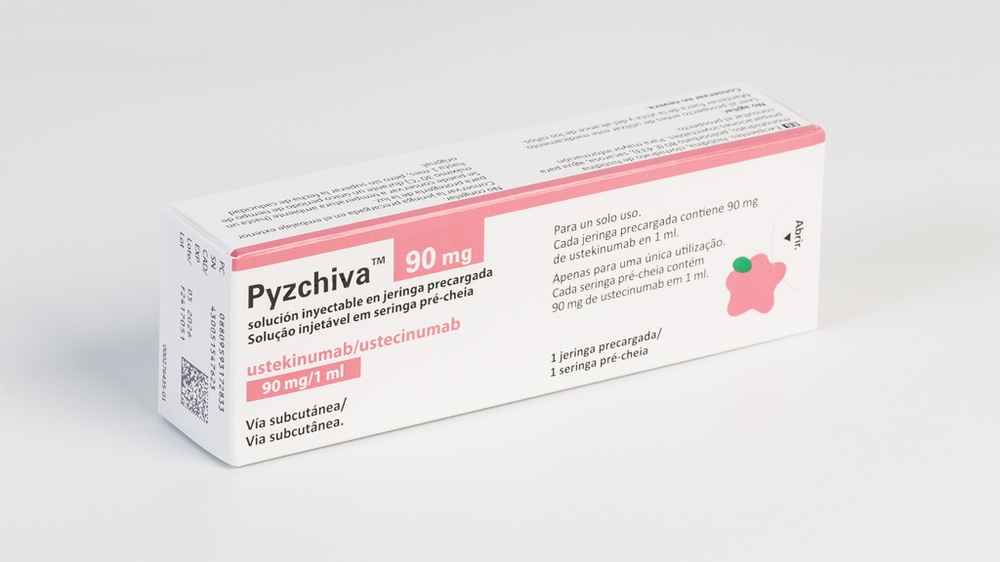
ПИЗЧИВА 90 МГ РАСТВОР ДЛЯ ИНЪЕКЦИЙ В ПРЕДНАПОЛНЕННОМ ШПРИЦЕ


Инструкция по применению ПИЗЧИВА 90 МГ РАСТВОР ДЛЯ ИНЪЕКЦИЙ В ПРЕДНАПОЛНЕННОМ ШПРИЦЕ
Введение
Прошпект: информация для пациента
Пизчива90мг раствор для инъекций в предварительно заполненном шприце
устекинумаб
Этот препарат подлежит дополнительному наблюдению, что позволит быстро обнаружить новую информацию о его безопасности. Вы можете внести свой вклад, сообщая о побочных эффектах, которые у вас могут возникнуть. В конце раздела 4 содержится информация о том, как сообщать о этих побочных эффектах.
Прочитайте весь прошпект внимательно перед началом использования этого препарата, поскольку он содержит важную информацию для вас.
Этот прошпект составлен для человека, который принимает препарат. Если вы являетесь родителем или опекуном ребенка, которому будет назначен Пизчива, пожалуйста, прочитайте эту информацию внимательно.
- Сохраните этот прошпект, поскольку вам может потребоваться прочитать его снова.
- Если у вас есть какие-либо вопросы, проконсультируйтесь с вашим врачом или фармацевтом.
- Этот препарат назначен только вам, и не следует давать его другим людям, даже если они имеют те же симптомы, что и вы, поскольку это может нанести им вред.
- Если вы испытываете побочные эффекты, проконсультируйтесь с вашим врачом или фармацевтом, даже если это побочные эффекты, которые не указаны в этом прошпекте. См. раздел 4.
Содержание прошпекта
- Что такое Пизчива и для чего она используется
- Что вам нужно знать перед началом использования Пизчивы
- Как использовать Пизчиву
- Возможные побочные эффекты
- Хранение Пизчивы
- Содержание упаковки и дополнительная информация
1. Что такое Пизчива и для чего она используется
Что такое Пизчива
Пизчива содержит активное вещество "устекинумаб", моноклональное антитело. Моноклональные антитела - это белки, которые специфически распознают и связываются с определенными белками организма.
Пизчива относится к группе препаратов, называемых "иммунодепрессантами". Эти препараты действуют путем ослабления части иммунной системы.
Для чего используется Пизчива
Пизчива используется для лечения следующих воспалительных заболеваний:
- Псориаз в виде бляшек - у взрослых и детей от 6 лет и старше
- Псориатический артрит - у взрослых
- Болезнь Крона средней и тяжелой степени - у взрослых
Псориаз в виде бляшек
Псориаз в виде бляшек - это заболевание кожи, которое вызывает воспаление, поражая кожу и ногти. Пизчива снижает воспаление и другие признаки заболевания.
Пизчива используется у взрослых с псориазом в виде бляшек средней и тяжелой степени, которые не могут использовать циклоспорин, метотрексат или фототерапию, или когда эти методы лечения не эффективны.
Пизчива используется у детей и подростков от 6 лет и старше с псориазом в виде бляшек средней и тяжелой степени, которые не могут переносить фототерапию или другие системные методы лечения, или когда эти методы лечения не эффективны.
Псориатический артрит
Псориатический артрит - это воспалительное заболевание суставов, которое обычно сопровождается псориазом. Если у вас активный псориатический артрит, сначала вам будут назначены другие препараты. Если вы не реагируете хорошо на эти препараты, вам может быть назначена Пизчива для:
- Снижения признаков и симптомов вашего заболевания.
- Улучшения вашей физической функции.
- Снижения повреждения суставов.
Болезнь Крона
Болезнь Крона - это воспалительное заболевание кишечника. Если у вас болезнь Крона, сначала вам будут назначены другие препараты. Если вы не реагируете должным образом или не можете переносить эти препараты, вам может быть назначена Пизчива для снижения признаков и симптомов вашего заболевания.
2. Что вам нужно знать перед началом использования Пизчивы
Не используйте Пизчиву
- Если вы аллергичны к устекинумабуили к любому другому компоненту этого препарата (перечисленному в разделе 6).
- Если у вас есть активная инфекция, которую ваш врач считает важной.
Если вы не уверены, что какой-либо из этих пунктов относится к вам, проконсультируйтесь с вашим врачом или фармацевтом перед использованием Пизчивы.
Предостережения и меры предосторожности
Проконсультируйтесь с вашим врачом или фармацевтом перед началом использования Пизчивы. Ваш врач проверит ваше состояние перед каждым лечением. Убедитесь, что вы сообщите вашему врачу о любом заболевании, которое у вас есть, перед каждым лечением. Ваш врач также спросит, были ли вы недавно рядом с кем-то, кто мог иметь туберкулез. Ваш врач осмотрит вас и проведет тест на обнаружение туберкулеза перед использованием Пизчивы. Если ваш врач считает, что вы находитесь в группе риска туберкулеза, он может назначить вам препараты для лечения.
Обратите внимание на серьезные побочные эффекты
Пизчива может вызывать серьезные побочные эффекты, включая аллергические реакции и инфекции. Вы должны обратить внимание на определенные признаки заболевания во время использования Пизчивы. См. полный список этих побочных эффектов в разделе "Серьезные побочные эффекты" раздела 4.
Перед использованием Пизчивы скажите вашему врачу:
- Если вы когда-либо имели аллергическую реакцию на устекинумаб.Проконсультируйтесь с вашим врачом, если вы не уверены.
- Если вы когда-либо имели какой-либо вид рака– это потому, что иммунодепрессанты типа устекинумаба ослабляют часть иммунной системы. Это может увеличить риск развития рака.
- Если вы получали лечение псориаза другими биологическими препаратами(препарат, произведенный из биологического источника и обычно вводимый путем инъекции) – риск развития рака может быть выше.
- Если у вас есть новые поражения или изменения пораженийв области псориаза или на здоровой коже.
- Если у вас есть недавняя инфекция.
- Если вы принимаете другие препараты для лечения псориаза и/или псориатического артрита– такие как другие иммунодепрессанты или фототерапия (когда ваш организм подвергается воздействию определенного типа ультрафиолетового света). Эти методы лечения также могут ослаблять часть иммунной системы. Не было проведено изучение использования этих методов лечения в сочетании с устекинумабом. Однако возможно, что это может увеличить вероятность развития заболеваний, связанных с ослабленной иммунной системой.
- Если вы получали инъекции для лечения аллергии– неизвестно, может ли устекинумаб влиять на эти методы лечения.
- Если вам 65 лет или более– вы имеете больше шансов приобрести инфекции.
Если вы не уверены, что какой-либо из этих пунктов относится к вам, проконсультируйтесь с вашим врачом или фармацевтом перед использованием Пизчивы.
Некоторые пациенты испытывали реакции, подобные системной красной волчанке, во время лечения устекинумабом, включая кожную красную волчанку или синдром, подобный системной красной волчанке. Проконсультируйтесь с вашим врачом немедленно, если вы испытываете красную, возвышенную и чешуйчатую кожную сыпь, иногда с более темной окантовкой, в областях кожи, подверженных воздействию солнца, или если они сопровождаются суставными болями.
Инфаркты миокарда и инсульты
В одном из исследований, проведенных на пациентах с псориазом, леченных устекинумабом, были обнаружены инфаркты миокарда и инсульты. Ваш врач будет регулярно проверять ваши факторы риска сердечно-сосудистых заболеваний и инсультов, чтобы обеспечить их адекватное лечение. Обратитесь за медицинской помощью немедленно, если вы испытываете боль в груди, слабость или необычные ощущения в одной стороне тела, паралич лица или аномалии речи или зрения.
Дети и подростки
Не рекомендуется использовать устекинумаб у детей младше 6 лет с псориазом в виде бляшек и у детей младше 18 лет с псориатическим артритом или болезнью Крона, поскольку это не было изучено в этой возрастной группе.
Использование Пизчивы с другими препаратами, вакцинами
Сообщите вашему врачу или фармацевту:
- Если вы используете, недавно использовали или можете использовать другие препараты.
- Если вы были недавно вакцинированы или собираетесь получить вакцину. Не следует назначать определенные типы вакцин (живые вакцины) во время использования Пизчивы.
- Если вы получали Пизчиву во время беременности, сообщите врачу вашего ребенка о вашем лечении Пизчивой перед тем, как ваш ребенок получит любую вакцину, включая живые вакцины, такие как вакцина БЦЖ (используемая для предотвращения туберкулеза). Не рекомендуется использовать живые вакцины для вашего ребенка в течение первых шести месяцев после рождения, если вы получали Пизчиву во время беременности, unless врач вашего ребенка рекомендует иное.
Беременность и лактация
- Предпочтительно избегать использования Пизчивы во время беременности. Неизвестны эффекты устекинумаба на беременных женщин. Если вы женщина детородного возраста, вам рекомендуется избегать беременности и использовать адекватные меры контрацепции во время использования устекинумаба и в течение как минимум 15 недель после последнего лечения устекинумабом.
- Сообщите вашему врачу, если вы беременны, считаете, что можете быть беременной, или планируете стать беременной.
- Пизчива может проникать через плаценту к плоду. Если вы получали Пизчиву во время беременности, ваш ребенок может иметь повышенный риск заразиться инфекцией.
- Важно сообщить врачам вашего ребенка и другим медицинским работникам, что вы получали Пизчиву во время беременности, прежде чем ваш ребенок получит любую вакцину. Не рекомендуется использовать живые вакцины, такие как вакцина БЦЖ (используемая для предотвращения туберкулеза), для вашего ребенка в течение первых шести месяцев после рождения, если вы получали Пизчиву во время беременности, unless врач вашего ребенка рекомендует иное.
- Устекинумаб может выделяться в грудное молоко в очень небольших количествах. Сообщите вашему врачу, если вы кормите грудью или планируете это делать. Вы и ваш врач решите, следует ли вам кормить грудью или использовать устекинумаб. Не делайте этого одновременно.
Вождение и использование машин
Влияние устекинумаба на способность управлять транспортными средствами и работать с машинами является незначительным или отсутствует.
Пизчива содержит полисорбат 80 (Е433)
Этот препарат содержит 0,04 мг полисорбата 80 (Е433) в каждом предварительно заполненном шприце (1 мл) эквивалентно 0,04 мг/мл. Полисорбаты могут вызывать аллергические реакции. Сообщите вашему врачу, если у вас есть известная аллергия.
3. Как использовать Пизчиву
Пизчива должна использоваться под руководством и наблюдением врача с опытом лечения заболеваний, для которых показана Пизчива.
Всегда следуйте точно инструкциям по введению этого препарата, указанным вашим врачом. В случае сомнений проконсультируйтесь с вашим врачом. Спросите вашего врача, когда должны быть сделаны инъекции и о последующих консультациях.
Какая доза Пизчивы вводится
Ваш врач решит, какая доза Пизчивы вам необходима, и как долго будет длиться лечение.
Взрослые от 18 лет и старше
Псориаз или псориатический артрит
- Рекомендуемая начальная доза составляет 45 мг Пизчивы. Пациенты, вес которых превышает 100 кг, могут начать с дозы 90 мг вместо 45 мг.
- После начальной дозы вы примете следующую дозу через 4 недели, а затем каждые 12 недель. Последующие дозы обычно такие же, как начальная доза.
Болезнь Крона
- Во время лечения ваш врач введет первую дозу примерно 6 мг/кг Пизчивы путем внутривенного капельного введения. После начальной дозы вы примете следующую дозу 90 мг Пизчивы через 8 недель, а затем каждые 12 недель путем подкожной инъекции.
- У некоторых пациентов после первой подкожной инъекции вводятся 90 мг Пизчивы каждые 8 недель. Ваш врач решит, когда вам следует получить следующую дозу.
Дети и подростки от 6 лет и старше
Псориаз
- Пизчива не показана для пациентов педиатрической группы с псориазом в виде бляшек с весом менее 60 кг, поскольку Пизчива доступна только в предварительно заполненных шприцах по 45 мг и 90 мг для подкожного введения. Следовательно, если требуется другая доза, должны использоваться другие формы устекинумаба, которые предлагают эту возможность.
- Ваш врач укажет правильную дозу для вас, включая количество (объем) Пизчивы, которое необходимо ввести для получения правильной дозы. Правильная доза для вас будет зависеть от вашего веса в момент каждого введения.
- Если ваш вес составляет от 60 кг до 100 кг, рекомендуемая доза составляет 45 мг Пизчивы.
- Если ваш вес превышает 100 кг, рекомендуемая доза составляет 90 мг Пизчивы.
- После начальной дозы вы примете следующую дозу через 4 недели, а затем каждые 12 недель.
Как вводится Пизчива
- Пизчива вводится путем подкожной инъекции. В начале вашего лечения медицинский персонал или медсестра могут вводить Пизчиву.
- Однако вы и ваш врач можете решить, что вы будете вводить Пизчиву самостоятельно. В этом случае вы будете обучены, как вводить Пизчиву самостоятельно.
- Для инструкций по введению Пизчивы см. "Инструкции по введению" в конце этого прошпекта.
Проконсультируйтесь с вашим врачом, если у вас есть вопросы о том, как вводить Пизчиву самостоятельно.
Если вы использовали больше Пизчивы, чем следует
Если вы использовали или вам было введено слишком много Пизчивы, немедленно проконсультируйтесь с вашим врачом или фармацевтом. Всегда носите с собой упаковку препарата, даже если она пуста.
Если вы пропустили введение Пизчивы
Если вы пропустили дозу, проконсультируйтесь с вашим врачом или фармацевтом. Не принимайте двойную дозу, чтобы компенсировать пропущенные дозы.
Если вы прекратили лечение Пизчивой
Прекращение использования устекинумаба не является опасным. Однако, если вы прекратите его использование, ваши симптомы могут снова появиться.
Если у вас есть другие вопросы о использовании этого препарата, проконсультируйтесь с вашим врачом или фармацевтом.
4. Возможные побочные эффекты
Как и все лекарства, это лекарство может вызывать побочные эффекты, хотя не все люди испытывают их.
Тяжелые побочные эффекты
Некоторые пациенты могут испытывать тяжелые побочные эффекты, которые могут потребовать срочного лечения.
Аллергические реакции– они могут потребовать срочного лечения. Свяжитесь со своим врачом или получите срочную медицинскую помощь немедленно, если вы заметите любой из следующих признаков.
- Тяжелые аллергические реакции ("анафилаксия") редки у населения, использующего устекинумаб (могут поражать до 1 из 1000 человек). Признаки включают:
- затруднение дыхания и глотания,
- низкое кровяное давление, которое может вызвать головокружение или легкие головные боли,
- отек лица, губ, рта или горла.
- Общие признаки аллергической реакции включают кожную сыпь и крапивницу (эти могут поражать до 1 из 100 человек).
В редких случаях были зарегистрированы аллергические реакции в легких и воспаление легких у пациентов, леченных устекинумабом. Сообщите своему врачу немедленно, если у вас есть симптомы, такие как кашель, затруднение дыхания и лихорадка.
Если у вас есть тяжелая аллергическая реакция, ваш врач может решить, что вам не следует использовать Пизчиву снова.
Инфекции– они могут потребовать срочного лечения. Свяжитесь со своим врачом немедленно, если вы заметите любой из этих признаков.
- Инфекции носа или горла и обычная простуда часто встречаются (могут поражать до 1 из 10 человек).
- Инфекции легких редки (могут поражать до 1 из 100 человек).
- Воспаление тканей под кожей ("целлюлит") редко встречается (может поражать до 1 из 100 человек).
- Герпес (тип болезненной сыпи с пузырями) редок (может поражать до 1 из 100 человек).
Устекинумаб может повлиять на вашу способность бороться с инфекциями. Некоторые из них могут быть тяжелыми и вызваны вирусами, грибами, бактериями (включая туберкулез) или паразитами, и среди них есть инфекции, которые в основном поражают людей с ослабленной иммунной системой (оппортунистические инфекции). Были зарегистрированы оппортунистические инфекции мозга (энцефалит, менингит), легких и глаз у пациентов, получающих лечение устекинумабом.
Вы должны следить за признаками инфекции, пока используете устекинумаб. Эти признаки включают:
- лихорадку, симптомы гриппа, ночные поты, потерю веса,
- чувство усталости или затруднения дыхания; кашель, который не проходит,
- горячую, красную и болезненную кожу или болезненную сыпь с пузырями,
- зуд при мочеиспускании,
- диарею,
- плохое зрение или потерю зрения,
- головную боль, напряжение шеи, чувствительность к свету, тошноту или путаницу.
Свяжитесь со своим врачом немедленно, если вы заметите любой из этих признаков инфекции, поскольку они могут быть признаками инфекций, таких как инфекции легких, кожные инфекции, герпес или оппортунистические инфекции, которые могут иметь тяжелые осложнения. Также вы должны сообщить своему врачу, если у вас есть любой тип инфекции, который не проходит или повторяется. Ваш врач может решить, что вам не следует использовать устекинумаб, пока инфекция не пройдет. Также свяжитесь со своим врачом, если у вас есть открытая рана или язва, которая может стать инфицированной.
Отслоение кожи – увеличение красноты и отслоение кожи на большой поверхности тела могут быть симптомами эритродермической псориазы или эксфолиативного дерматита, которые являются тяжелыми заболеваниями кожи. Если вы заметите любой из этих симптомов, вы должны сообщить об этом своему врачу немедленно.
Другие побочные эффекты
Частые побочные эффекты(могут поражать до 1 из 10 человек):
- Диарея
- Тошнота
- Рвота
- Чувство усталости
- Чувство головокружения
- Головная боль
- Зуд ("прурит")
- Боль в спине, мышцах или суставах
- Боль в горле
- Краснота и боль в месте инъекции
- Синусит
Редкие побочные эффекты(могут поражать до 1 из 100 человек):
- Дентальные инфекции
- Вагинальные инфекции, вызванные дрожжами
- Депрессия
- Закупорка или конгестия носа
- Кровотечение, синяки, уплотнение, отек и зуд в месте инъекции
- Чувство слабости
- Птоз и атрофия мышц на одной стороне лица ("фациальный паралич" или "Белл паралич"), который обычно временный
- Изменение псориаза с краснотой и новой сыпью на коже, иногда сопровождаемой лихорадкой (пустулезная псориаз).
- Отслоение кожи (эксфолиация кожи)
- Акне
Очень редкие побочные эффекты(могут поражать до 1 из 1000 человек):
- Краснота и отслоение кожи на большой поверхности тела, которые могут вызвать зуд или боль (эксфолиативный дерматит). Могут развиваться подобные симптомы, такие как изменение псориаза (эритродермическая псориаз)
- Воспаление мелких кровеносных сосудов, которое может вызвать сыпь на коже с мелкими красными или фиолетовыми бугорками, лихорадку или боль в суставах (васкулит)
Очень редкие побочные эффекты(могут поражать до 1 из 10 000 человек)
- Пузыри на коже, которые могут быть красными и вызывать зуд и боль (пемфигус).
- Кожный lupus или lupus-подобный синдром (красная, возвышенная и чешуйчатая сыпь на коже, открытой для солнца, возможно сопровождаемая болью в суставах).
Сообщение о побочных эффектах
Если вы испытываете любой побочный эффект, проконсультируйтесь со своим врачом или фармацевтом, даже если это возможные побочные эффекты, которые не указаны в этом описании. Также вы можете сообщить об этом напрямую через национальную систему уведомления, включенную в Приложение V. Сообщая о побочных эффектах, вы можете внести свой вклад в предоставление более полной информации о безопасности этого лекарства.
5. Хранение Пизчивы
- Храните это лекарство в недоступном для детей месте.
- Храните в холодильнике (2°C и 8°C). Не замораживайте.
- Храните предварительно заполненную шприц-инъектор в наружной упаковке, чтобы защитить его от света.
- Если необходимо, отдельные предварительно заполненные шприц-инъекторы Пизчивы также могут храниться при комнатной температуре до 30°C в течение одного периода времени до 1 месяца в оригинальной упаковке, чтобы защитить их от света. Запишите дату, когда предварительно заполненный шприц-инъектор был впервые удален из холодильника, в предусмотренном месте на наружной упаковке. В конце этого периода его можно снова хранить в холодильнике. Утилизируйте шприц-инъектор, если он не используется в течение 1 месяца хранения при комнатной температуре или после истечения срока годности, в зависимости от того, что наступит раньше.
- Не встряхивайте предварительно заполненные шприц-инъекторы Пизчивы. Продолжительное энергичное встряхивание может повредить продукт.
Не используйте это лекарство:
- После даты истечения срока годности, указанной на этикетке и упаковке после "CAD/EXP". Дата истечения срока годности – последний день месяца, указанного.
- Если жидкость изменила цвет, стала мутной или содержит посторонние частицы, плавающие в ней (см. раздел 6 "Вид Пизчивы и содержимое упаковки").
- Если вы знаете или предполагаете, что лекарство было подвергнуто воздействию экстремальных температур (например, случайного нагрева или замораживания).
- Если продукт был энергично встряхнут.
Пизчива предназначена для одноразового использования. Вы должны утилизировать неиспользованный продукт, оставшийся в шприц-инъекторе. Лекарства не должны выбрасываться в канализацию или в мусор. Спросите у своего фармацевта, как утилизировать упаковку и лекарства, которые вам больше не нужны. Таким образом, вы поможете защитить окружающую среду.
6. Содержание упаковки и дополнительная информация
Состав Пизчивы
- Активное вещество - устекинумаб. Каждая предзагруженная шприц содержит 90 мг устекинумаба в 1 мл.
- Другие компоненты - гистидин, моногидрат хлористого гистидина, полисорбат 80 (Е 433), сахароза, вода для инъекционных препаратов.
Внешний вид Пизчивы и содержание упаковки
Пизчива - прозрачный инъекционный раствор, бесцветный или светло-желтого цвета. Раствор может содержать несколько прозрачных или белых белковых частиц. Он представлен в упаковке, содержащей 1 предзагруженную шприц из стекла объемом 1 мл. Каждая предзагруженная шприц содержит 90 мг устекинумаба в 1 мл инъекционного раствора.
Владелец разрешения на маркетинг и производитель
Samsung Bioepis NL. B.V.
Olof Palmestraat 10
2616 LR Delft
Нидерланды
Для получения дополнительной информации о этом лекарственном средстве можно обратиться к местному представителю владельца разрешения на маркетинг:
Бельгия/Белгique/Бельгия Sandoz nv/sa Тел.: +32 2 722 97 97 | Литва Sandoz Pharmaceuticals d.d filialas Тел.: +370 5 2636 037 |
| Люксембург/Люксембург Sandoz nv/sa Тел.: +32 2 722 97 97 |
Чешская Республика Sandoz s.r.o. Тел.: +420 225 775 111 | Венгрия Sandoz Hungária Kft. Тел.: +36 1 430 2890 |
Дания/Норвегия/Исландия/Швеция Sandoz A/S Тел.: +45 63 95 10 00 | Мальта Sandoz Pharmaceuticals d.d. Тел.: +35699644126 |
Германия Hexal AG Тел.: +49 8024 908 0 | Нидерланды Sandoz B.V. Тел.: +31 36 52 41 600 |
Эстония Sandoz d.d. Eesti filiaal Тел.: +372 665 2400 | Австрия Sandoz GmbH Тел.: +43 5338 2000 |
Греция SANDOZ HELLAS ΜΟΝΟΠΡΟΣΩΠΗ Α.Ε. Тел.: +30 216 600 5000 | Польша Sandoz Polska Sp. z o.o. Тел.: +48 22 209 70 00 |
Испания Sandoz Farmacéutica, S.A. Тел.: +34 900 456 856 | Португалия Sandoz Farmacêutica Lda. Тел.: +351 21 000 86 00 |
Франция Sandoz SAS Тел.: +33 1 49 64 48 00 | Румыния Sandoz Pharmaceuticals SRL Тел.: +40 21 407 51 60 |
Хорватия Sandoz d.o.o. Тел.: +385 1 23 53 111 | Словения Sandoz farmacevtska družba d.d. Тел.: +386 1 580 29 02 |
Ирландия Rowex Ltd. Тел.: + 353 27 50077 | Словакия Sandoz d.d. - organizacná zložka Тел.: +421 2 48 200 600 |
Италия Sandoz S.p.A. Тел.: +39 02 96541 | Финляндия Sandoz A/S Тел.: +358 10 6133 400 |
Кипр SANDOZ HELLAS ΜΟΝΟΠΡΟΣΩΠΗ Α.Ε. Тел.: +30 216 600 5000 | |
Латвия Sandoz d.d. Latvia filiale Тел.: +371 67 892 006 |
Следимость
Для улучшения следимости биологических лекарственных средств название и номер партии лекарственного средства должны быть четко зарегистрированы.
Дата последнего обзора этой инструкции: ММ/ГГГГ
Другие источники информации
Подробная информация о этом лекарственном средстве доступна на сайте Европейского агентства по лекарственным средствам: https://www.ema.europa.eu/.
Инструкции по введению
В начале лечения медицинский работник поможет вам с первой инъекцией. Однако возможно, что вы и ваш врач решите, что вы можете самостоятельно вводить Пизчиву. В этом случае они научат вас, как вводить Пизчиву. Обсудите с вашим врачом любые вопросы, связанные с введением инъекций.
- Не смешивайте Пизчиву с другими инъекционными жидкостями.
- Не встряхивайте предзагруженные шприцы Пизчивы. Лекарство может испортиться, если его сильно встряхнуть. Не используйте лекарство, если оно было сильно встряхнуто.
Фигура 1 показывает, как выглядит предзагруженная шприц.
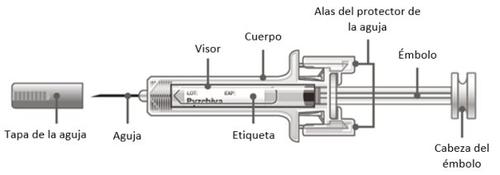
Фигура 1
- Проверьте количество предзагруженных шприцев и подготовьте материалы:
Подготовка к использованию предзагруженной шприцы
- Выньте предзагруженную шприц из холодильника. Оставьте шприц вне упаковки на 30 минут. Это позволит жидкости достичь комфортной температуры для введения (комнатная температура). Не нагревайте предзагруженную шприц никаким другим способом (например, не нагревайте в микроволновой печи или в горячей воде). Не снимайте крышку иглы, пока ждете, пока температура не достигнет комнатной.
- Держите предзагруженную шприц за корпус с закрытой иглой, направленной вверх.
- Не берите шприц за головку поршня, поршень, крылья защитника иглы или крышку иглы.
- Не вынимайте поршень ни в коем случае.
- Не снимайте крышку предзагруженной шприцы, пока вам не будет указано.
Проверьте предзагруженную шприц, чтобы убедиться, что
- Количество предзагруженных шприцев и концентрация правильны
- Если ваша доза составляет 90 мг, у вас будет предзагруженная шприц с 90 мг Пизчивы.
- Это правильное лекарство.
- Срок годности не истек.
- Предзагруженная шприц не повреждена.
- Раствор в предзагруженной шприце прозрачный и бесцветный или слегка желтый.
- Раствор в предзагруженной шприце не имеет необычного цвета, не мутный и не содержит посторонних частиц.
- Раствор в предзагруженной шприце не заморожен.
Подготовьте все необходимое и положите его на чистую поверхность, включая антисептические салфетки, вату или марлю и контейнер для острых предметов.
- Выберите и подготовьте место инъекции:
Выберите место инъекции (см. Фигуру 2).
- Пизчива вводится путем инъекции под кожу (подкожно).
- Некоторые подходящие места для инъекции - верхняя часть бедра или область живота (абдомена) как минимум на 5 см от пупка.
- По возможности, не используйте участки кожи, которые показывают признаки псориаза.
- Если кто-то другой вводит вам инъекцию, то он или она также могут выбрать верхнюю часть руки как место инъекции.
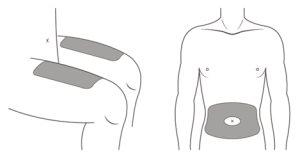
*Серым цветом обозначены рекомендуемые места инъекции.
Фигура 2
Подготовьте место инъекции
- Тщательно вымойте руки с мылом и теплой водой.
- Очистите кожу в месте инъекции антисептической салфеткой.
- Нетрогайте эту область снова перед инъекцией.
- Недуйте и не обмахивайте чистую область.
- Снимите крышку иглы (см. Фигуру 3):
- Крышка иглы недолжна быть снята, пока вы не будете готовы к инъекции.
- Держите предзагруженную шприц и держите корпус шприцы одной рукой.
- Снимите крышку иглы и избавьтесь от нее. Не трогайте поршень, пока делаете это.
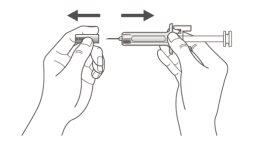
Фигура 3
- Возможно, вы заметите воздушную пузырьку в предзагруженной шприце или каплю жидкости на конце иглы. Оба варианта нормальны и не требуют удаления.
- Не трогайте иглу и не позволяйте ей касаться любой поверхности.
- Не используйте предзагруженную шприц, если она упала без крышки иглы. Если это происходит, сообщите об этом вашему врачу или фармацевту.
- Введение дозы должно быть сделано сразу после снятия крышки иглы.
- Введение дозы:
- Держите предзагруженную шприц одной рукой между указательным и средним пальцами, положите большой палец на головку поршня и другой рукой аккуратно зажмите складку кожи на месте инъекции большим и указательным пальцами. Не сжимайте.
- Не вынимайте поршень ни в коем случае.
- С одним быстрым движением введите иглу через кожу до тех пор, пока она не войдет полностью (см. Фигуру 4).
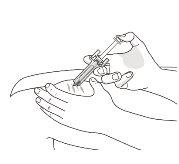
Фигура 4
- Введение всего лекарства путем продвижения поршня до тех пор, пока его головка не окажется полностью между крыльями защитника иглы (см. Фигуру 5).
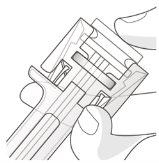
Фигура 5
- Когда вы продвинете поршень до конца, поддерживайте давление на головку поршня, выньте иглу и отпустите кожу (см. Фигуру 6).
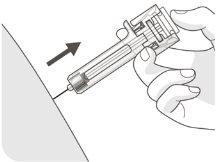
Фигура 6
- Медленно уберите большой палец с головки поршня, чтобы пустая шприц переместилась вперед, пока игла не окажется полностью закрыта защитником, как показано на Фигуре 7:
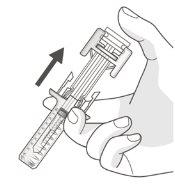
Фигура 7
- После инъекции:
- Нажмите на место инъекции антисептической салфеткой в течение нескольких секунд после инъекции.
- Может появиться небольшое количество крови или жидкости в месте инъекции. Это нормально.
- Можно нажать на место инъекции ватой или марлей и держать в течение 10 секунд.
- Не трите кожу в месте инъекции. Можно покрыть место инъекции пластырем, если необходимо.
- Утилизация:
- Использованные шприцы должны быть помещены в контейнер, устойчивый к проколам, подобный контейнеру для острых предметов (см. Фигуру 8). Для вашей безопасности и здоровья, а также для безопасности других, никогда не используйте шприц повторно. Утилизируйте контейнер для острых предметов в соответствии с местными правилами.
- Антисептические салфетки и другие материалы могут быть выброшены в мусор.
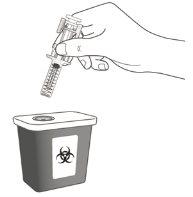
Фигура 8
- Страна регистрации
- Активное вещество
- Требуется рецептДа
- Производитель
- СоставPOLISORBATO 80 (0,04 mg mg), SACAROSA (42,50 mg mg)
- Информация носит справочный характер и не является медицинской рекомендацией. Перед приемом любых препаратов проконсультируйтесь с врачом. Oladoctor не несет ответственности за медицинские решения, принятые на основе этого контента.
- Аналоги ПИЗЧИВА 90 МГ РАСТВОР ДЛЯ ИНЪЕКЦИЙ В ПРЕДНАПОЛНЕННОМ ШПРИЦЕФорма выпуска: ИНЪЕКЦИОННЫЙ РАСТВОР ДЛЯ ИНФУЗИЙ, 130 мгАктивное вещество: УстекинумабПроизводитель: Accord Healthcare S.L.U.Требуется рецептФорма выпуска: ИНЪЕКЦИОННЫЙ РАСТВОР, 45 мгАктивное вещество: УстекинумабПроизводитель: Accord Healthcare S.L.U.Требуется рецептФорма выпуска: ИНЪЕКЦИОННЫЙ РАСТВОР, 90 мгАктивное вещество: УстекинумабПроизводитель: Accord Healthcare S.L.U.Требуется рецепт





